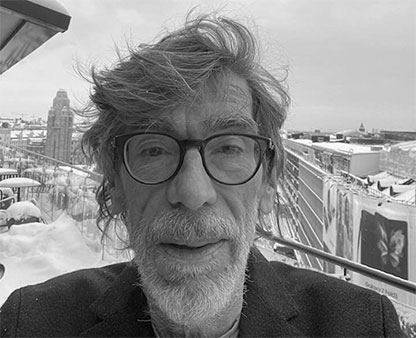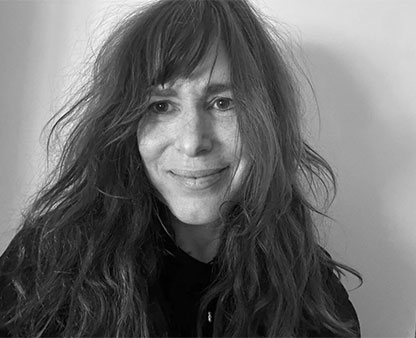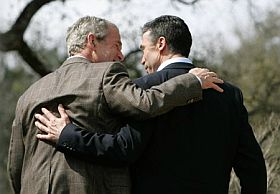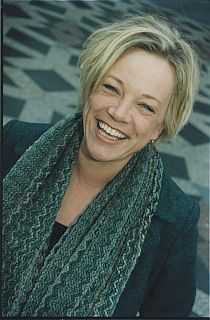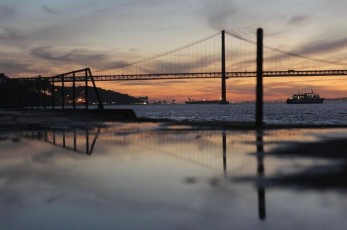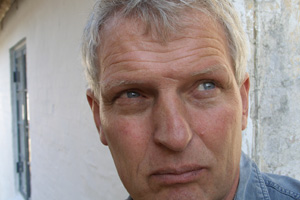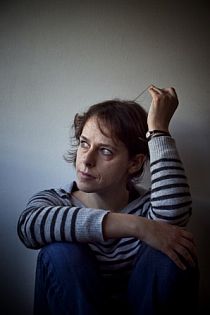Fulde af trodsalthumør behandler hendes film alvorlige sager og konstruerer verdener, hvor udveje og lyssyn overalt er til stede som konkret iagttaget realitet – og den vamle sentimentalitet og organiserede bedreviden helt ukendte størrelser…
Ulla Boye er månedens instruktør i FILMKLUB FOF i Randers. Vi skal se ”Kun med hjertet” og før den klip fra andre af hendes film. Og bagefter diskutere det hele.
LEENDE FILM
Lattermilde Ulla Boye laver leende film. Også om tunge emner. Fulde af trodsalthumør behandler hendes film alvorlige sager og konstruerer verdener, hvor udveje og lyssyn overalt er til stede som konkret iagttaget realitet – og den vamle sentimentalitet og organiserede bedreviden helt ukendte størrelser.
“Ludvig og lidenskaben” fra 1999 er om en enlig mand og hans gennemorganiserede dagligdag, “To må man være” fra 2001 var en folkelig succes på tv vistnok uden lige blandt dokumentarfilm. Det er en række ti minutters film med par, som har været gift i mere end et par årtier og stadig er forelskede. Og fulde af mild latter. “Rêverie”, 2002 er korte sansninger i en græsk landsby, et forelsket smil med kant af smerte og “Dage med Kathrine”, 2003 er en hjerteknuser af en biografi over en kvinde, som sandelig ikke har haft det let, ikke har det let, det forstår man i hendes overdådighed af begavet og selvironisk fortællekunst, som Ulla Boye har lokket ud af hende. Ja, så det forstås gennem tårer og – ved latter. (Blogindlæg 09-01-2009)
TO MÅ MAN VÆRE (2001)
Portrættet er en vanskelig kunst. Den som portrætteres skal sidde længe. For han skal iagttages af maleren, som skal finde alle overensstemmelser og uoverensstemmelser. Alle ligheder med sig selv og alle forskelligheder. Fra sig selv. Så dette menneske foran ham skiller sig ud fra ham og bringes i kontakt med ham. På én gang.
Dobbeltportrættet er endnu vanskeligere. Her går forbindelseslinjerne, disse elektriske impulser, vi benævner udstråling, nærvær, forståelse ikke alene mellem maler og modeller, men også mellem de to.
Når de to i dobbeltportrættet så kender hinanden gennem mere end tyve år i ægteskab, er med ét – ud over alt det nævnte – alle disse forbindelsestråde mellem dem det mest mærkbare, og det bliver det som skal skildres først og fremmest. Mellem de to i rammen findes det gnistgab af nerveender tæt på hinanden, som Paulus vier det største af alle ord.
Det er den opgave Ulla Boye og filmholdet stillede sig. De prøvede først én gang. Anbragte kameraet foran to, en kvinde og en mand, som instruktøren havde lært at kende gennem researchens lange samtale. En mand og en kvinde i en båd, hvor de bor. Der i kahytten sidder de og fortæller. Og underet sker: de åbner sig og indvier os i hemmeligheden. Sådan lykkes det at blive sammen og elske hinanden.
Denne muntert og musikalsk klippede bagatel havde premiere på Odense Festival sidste år. Man kunne bestemt lide den. Det var ikke til at tage fejl af, når man sad i salen. Ulla Boye og Lasse Jensen ville så gerne videre med syv mere. Ulla Boye tog rundt i landet og fandt de medvirkende par. De skulle kunne det der, de skulle komme fra forskellige egne, fra forskellige kulturer, fra land som by. Der fandtes flere. Og det forunderlige kunne gentages. Nu foreligger resultatet.
Hvordan gik det til? Jeg tror det er instruktørens særlige evne som søger og lytter, der gjorde det. Der skulle ses og høres efter og vælges midt i nærværet. Men det skulle også bringes sammen i fotografens ramme, som her blev så afgørende, fordi den ikke siden ændredes. Og så måtte fotografen og tonemesteren opmærksomt registrere disse samvær, skabe det forråd af erindring i computerens harddisk Der skulle uafbrudt ses og lyttes og vælges.
Bagefter sad klipperen og instruktøren i klipperummet med dette potentielle erindringsmateriale. Igen skulle der ses og lyttes og vælges: en bevægelse af en hånd, et kast med hovedet, et særligt blik, en bestemt formulering udgjorde erindringen om samværene. Og valgene blev monteret med små sorte mellemrum i disse billedrækker vi kalder film. Her blev dobbeltportrætterne til. I atter et nærvær. Tro mod de første.
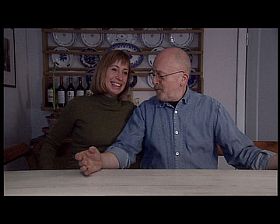
Når vi erindrer et andet menneske, husker to sammen, to elskende, vi mødte og iagttog, samler vi et billede af øjeblikke. Klip i vores hukommelse så at sige. Theodor Christensen sagde vistnok, at hver gang to scener lagdes sammen i klippebordet, var det som når kirurgen forbandt hundredvis af nervetråde. I klipperummet ovre på Easy Film talte vi meget om den sorte markering af de der klip, om det at montagen derved blev synlig, fordi man ser sytrådene.
I Ulla Boyes, Jørgen Johanssons, Kasper Munks, Gregers Kjars, Mette Esmarks, Marie Louise Bordinggaards, Mette Zeruneiths og Lasse Jensens otte dobbeltportrætter ser vi således nu om et øjeblik, hvordan billedet af selve kærligheden, måske – er syet sammen. Rigtig god fornøjelse. (28. september 2001, tale ved premieren)
RÊVERIE (2002)
Hun lægger sig til at sove, og dagens billedrester i øjnene passerer hjernen. Lige før hun falder i den dybe søvn. Dette fjerlette drømmeri er for det drømmende kamera, som ellers nærmest havde fri. Næsten af sig selv (og selvfølgelig er det ikke sådan) optager det tydelige billeder af stedets farver og rum og ting – af havet, marken, dyrene, menneskene, køkkenet, kirken. Så jeg ved jeg er i en lille græsk landsby ved havet. Det er enkle, selvfølgelige billeder. Det er akademisk fotografi, at scenen er drømmen før søvnen gør dem ikke eksperimenterende eller noget. Det er præcis og opmærksom impressionisme.
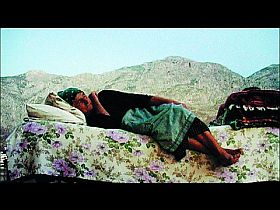
På mange måder er disse anderledes optagelser anderledes på den måde, som jeg ser i Søborgs optagelser til ”Under New York” (1996). De to film er i slægt med hinanden. Det er vidt forskellige steder, det er en lille film og en stor film, ok, men fotografernes dristige følsomhed ligner hinanden også deri, at den konkluderer, at tingene hænger sammen, at tiden findes. Og et tiårs karakter skrives i hvert sit kamera.
Fotografen Jørgen Johansson er med ”Rêverie” på en lille koncentreret ferie fra rækken af store spillefilmopgaver. Imidlertid har Johansson for Ulla Boye også fotograferet den gennemførte tv-succes “To må man være” (2001) og den prægnante og lige så ægte folkelige og opmærksomt iagttagne “Kun med hjertet” (2008) (Fra ”Billedets skriven” i Dirk Brüel m. fl., red.: ”Fotografens Øje”, 2009)
DAGE MED KATHRINE (2003)
Den skotske dokumentarist John Grierson har til sit fag en mærkelig bemærkning, som jeg igen og igen vender tilbage til. Det gælder om for dokumentarfilmen at finde sit sted, at gøre dette steds drama til filmens drama og med filmen bygge stammens værdighed op. Sted og drama. Værdighed. Her står vi ved en central bestemmelse for den klassiske dokumentarfilm: det gælder om at bygge op, ikke rive ned. Når dokumentarfilminstruktøren beskrev livet på stillehavsøen, i landsbyen i bjergene, i fiskerbyen ved Atlanterhavet.
Ulla Boye skildrede for nogen tid siden den danske stamme. I en række korte film, hvor ægteparrene, som stammen består af, omgivet af den særlige sproglige fortrolighed, vi kalder lune, fortæller om hinanden og snakker med hinanden. Og Boye demonstrerer i denne filmrække, hvad den griersonske værdighed kan være limet sammen af. Elementerne er indlevelse og humor. DR viser stadigvæk de film. Stammen har brug for den opbygning. Måske især på tv, hvor en anden, mindst lige så vigtig dokumentarisk tradition, den journalistiske, har så travlt med at afdække, travlt med at rive ned. Det er en anden opgave. Lige så vigtig, altså. Sådan holder eksistentielle elementer hinanden i balance i en indsigtens arbejdsdeling.
I dag skal vi se en film om menneskelig værdighed, hvor mennesket er helt alene. Det er Kathrine Jacobsen, der som medvirkende så generøst og, vil vi indse, modigt byder os indenfor i sit hjem, i sin erfaring.
I den film er det menneskets værdighed, som bygges op. Ikke Kathrine Jacobsens alene, ikke stammens alene, men hele den gudsskabte eksistens.
Som Gud berøver Job alt, ejendom, formue, familie, helbred, berøver Kathrine Jacobsen sig selv alt. Men som Job bevarer sin tro, bevarer hun sin, som er troen på det humane, på livet, på sig selv. Og hun giver sin tro navnet friheden. Når Kathrine Jacobsen drikker med vilje, er hun stadigvæk fri, fortæller hun os.
Og vi forstår hende i det samvær, vi aldrig havde etableret alene, et samvær, som Ulla Boye forærer os med dette dokumentariske arbejde. Ulla Boye har været til stede (og stedet er dette andet Griersonbegreb), hun har talt og spurgt og lyttet. Registreret og samlet ind. Så hensynsfuldt og nænsomt. Så antastelsen blev mindst mulig. Så fortroligheden dukkede op, og humoren og lunen. Skønheden i umistelige glimt og autenticiteten hele tiden.
Mette Esmark har så siddet med materialet og instruktøren i klipperummet og lyttet og lyttet og kigget og kigget. Og valgt ud og lagt væk og flyttet om. I dage og uger. Hvor jeg dog beundrer hende og hendes håndværk. Som på et maleri af Hammershøi vender på filmens plakat den rygvendte kvinde sig om. I skønhed og værdighed. Sådan er portrættets øjeblik. Med filmens forløb opbygger Esmark det drama (det sidste af Griersonordene), dramaet af smerte og glæde, et sådant øjeblik vokser ud af.
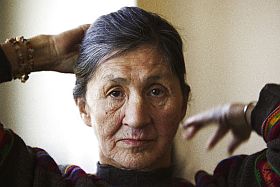
Kære Ulla Boye og Mette Esmark, det skal I have tak for. Tak for endnu en film. Kære Kathrine Jacobsen. Du har modigt vist os din tillid. Vi lover dig at tage vare på den og bruge den. Filmen handler om dig – og om os. Må jeg ønske publikum en god filmkørsel. Tak. (12. september 2003, tale ved premieren)
GULDDOK 2008/CPH:DOX 4
Danish Producers Association distributed documentary prizes at the opening of CPH:DOX 2008. 3 films took the five prizes. All three films have been reviewed at filmkommentaren.dk In Danish. All three films have very local themes.
Årets GuldDok/Grand Prix: Instruktøren Ulla Boyes “Kun med hjertet”, der handler om hverdagen på Kofoeds Skole i København. Koncern TV- og Filmproduktion.
Bedste lange dokumentar/Best feature length doc: Instruktørerne Mads Kamp Thulstrups og Carsten Søsteds “…Og det var Danmark!”, filmen om det danske landsholds udvikling fra 70’erne til EM-triumfen i 1992. SF Film Production.
Bedste korte dokumentar/Best short doc: Instruktøren Janus Metz’ “Fra Thailand til Thy”, om thailandske kvinder, der søger lykken i det nordlige Danmark. Research: Sine Plambech. Cosmo Doc.
Bedste foto/Best Camerawork: Lars Skree og Henrik Bohn Ipsen for “Fra Thailand til Thy”.
Bedste klip/Best montage: Janus Billeskov Jansen, Stig Bilde og Mette Esmark for “Kun med hjertet”. (Tue Steen Müller, Blogindlæg 07-11-2008)
KUN MED HJERTET KAN MAN RIGTIGT SE (2008)
På Odense festivalen kan man så se kronen på værket, instruktørens nye film. Den har vi ventet længe på. Og den er værd at vente på. Den kan vist alt det Ulla Boye kan. Og det er en del. Selvfølgelig åbner den i en set scene, set så tydeligt med hjertet, netop som Saint-Exupérys tamgjorte ræv i titlens citat pointerer over for den lille prins. Øjet alene ville ikke se det, Boye og fotografen Jørgen Johansson ser til os. Det væsentlige er usynligt for øjet, tilføjer jo ræven. Og scenen er så også lyttet af de tre klippere, den er balanceret, den er lang, og alt muligt andet. Den er en lattermild dialog mellem hende og ham i kantinen på Kofoeds Skole. Og det fortsætter bare. Det er en vidunderlig film, en ægte dokumentarisk komedie. Glæd jer!
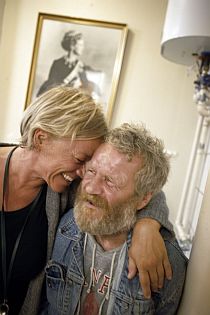
Ulla Boye: “Kun med hjertet kan man rigtigt se”, 2008. Kamera: Jørgen Johansson, klip: Mette Esmark, Stig Bilde og Janus Billeskov Jansen, produktion: Koncern www.koncern.dk Distribueres på Filmstriben www.filmstriben.dk (Blogindlæg 16-08-2008)

